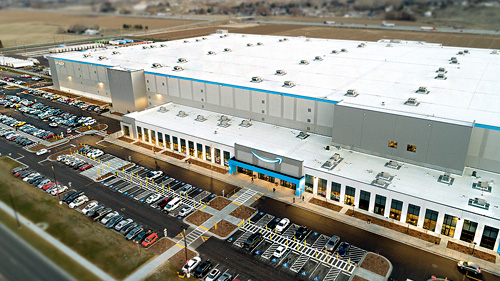In Focus: The Impact of E-Commerce on Industrial Real Estate
E-commerce fulfillment often demands three to four times the logistics space of traditional brick-and-mortar retail replenishment.
Q2 2022

Over the last two years, the sweet spot for e-commerce demand has been facilities ranging from 500,000 sf to 1.0 msf as the appetite for large distribution centers persists. Meanwhile, demand for warehouses greater than 1.0 msf fell by 23.7 percent from Q4 2020 to Q4 2021 due in part to the dwindling options for spaces of this size. In the first quarter of 2022, the market saw 61 leases over 500,000 sf; 25 of those leases were e-commerce related. In the 300,000 to 500,000 sf range, there were 36 leases related to 3PL or e-commerce business.
As consumers become more accustomed to purchasing online, their expectations with regard to delivery service and speed mount. Transportation costs account for nearly 65 percent of total logistics costs and have become the focus of any strategy aiming to reduce supply chain costs. Inefficiencies converge around transportation, especially in dense urban areas. For e-commerce occupiers, reducing the delivery distance to 30 minutes or less is critical.
Intense Use of Logistics Space
E-commerce fulfillment requires intense use of logistics space, often demanding three to four times the logistics space of traditional brick-and-mortar retail replenishment. Online order fulfillment necessitates higher nominal inventory levels given the product variety and the fact that parcel shipping requires much more space than palletized shipping. Furthermore, e-fulfillment often includes other value-add services such as assembly and reverse logistics.
Online sales surged more than four and a half times faster than total retail sales in 2020, growing by a staggering 31.8 percent, the highest annual growth of any year. Because e-commerce fulfillment is much more space-intensive than traditional warehousing, the long-term structural growth rate of logistics real estate has increased in tandem with the growth of e-commerce, and this is expected to continue. Digital sales soared in 2020 amid the pandemic and grew by 14.6 percent in 2021, equating to $870.8 billion being spent online.
Online sales surged more than four and a half times faster than total retail sales in 2020, growing by a staggering 31.8 percent, the highest annual growth of any year and more than double the sizeable 14.1 percent jump in 2019. That propelled U.S. e-commerce penetration as a percentage of total core retail sales to a record high of 21.9 percent by Q2 2020 at the height of the pandemic and lockdowns.
Although roughly one-fifth of spending continues to come from digital orders, the e-commerce share of core retail sales declined to 19.1 percent as of Q4 2021. This is more a reflection of the significant rebound in brick-and-mortar sales that has steadily occurred as the economy reopened. It is now safe to say that the online shopping trends brought on by the pandemic are the new normal, and many retail categories have plenty of runway left to go.
Supply chain investments made due to the ongoing pandemic such as technology, automation, and strategic site selection are likely to support increased digital sales in the future. This is especially true for segments that had low e-commerce penetration prior to the pandemic that had also recorded significant increases in online market share, such as the grocery and home improvement categories.
Project Announcements
Australia-Based Aquatic Leisure Technologies Group Plans Opp, Alabama, Manufacturing Operations
12/11/2025
Teradyne Plans Wixom, Michigan, Robotics Operations
12/11/2025
Robinson Plans Altoona, Iowa, Manufacturing Operations
12/11/2025
BioTouch Expands Columbus, Georgia, Operations
12/11/2025
Natrion Plans Erie County, New York, Battery Components Operations
12/11/2025
Czech-Based GZ PrintPak Expands Mount Pleasant, Wisconsin, Manufacturing Operations
12/11/2025
Most Read
-
The Workforce Bottleneck in America’s Manufacturing Revival
Q4 2025
-
Rethinking Local Governments Through Consolidation and Choice
Q3 2025
-
First Person: Filter King’s Expansion Playbook
Q3 2025
-
Lead with Facts, Land the Deal
Q3 2025
-
How Canada Stays Competitive
Q3 2025
-
Investors Seek Shelter in Food-Focused Real Estate
Q3 2025
-
America’s Aerospace Reboot
Q3 2025